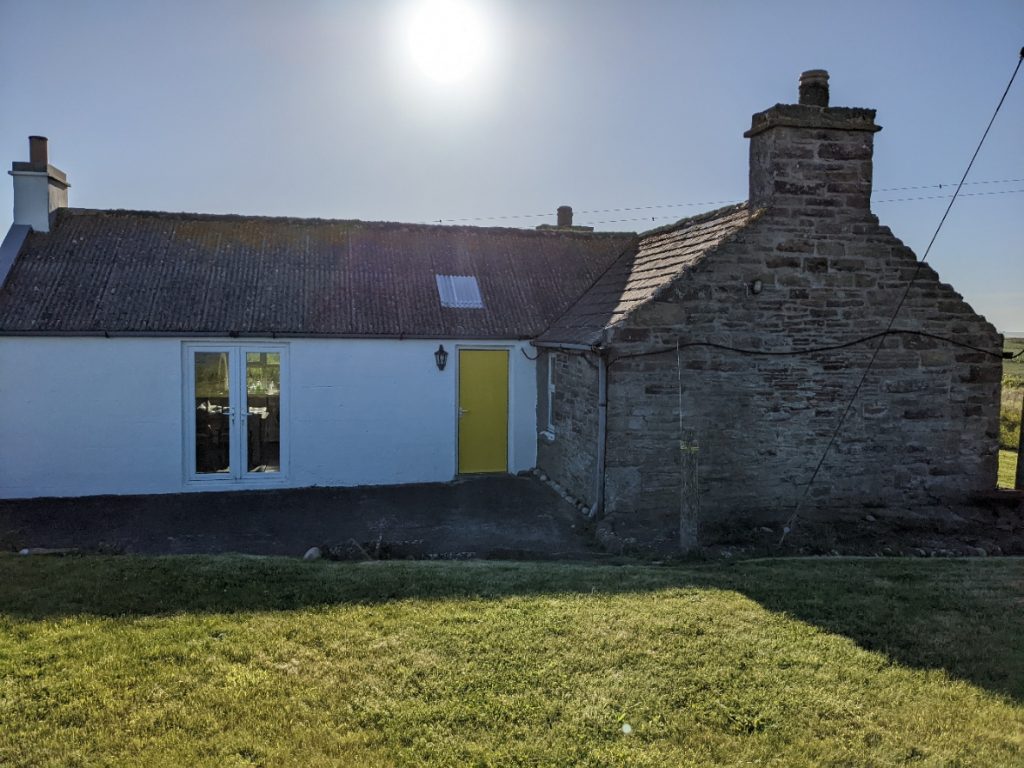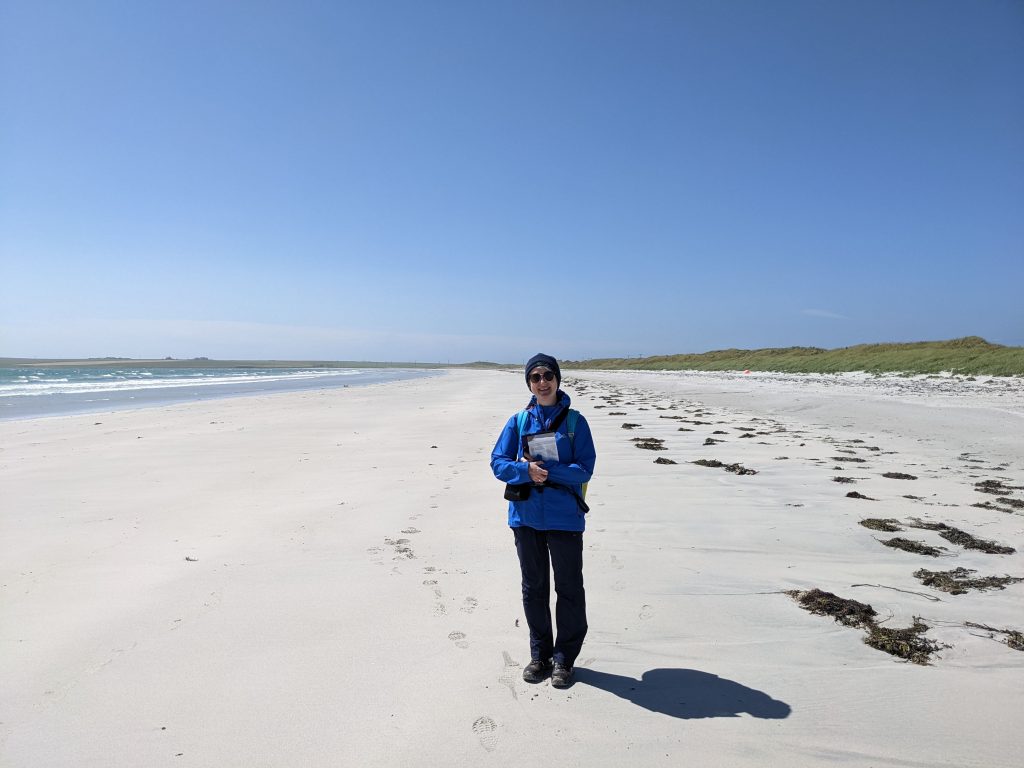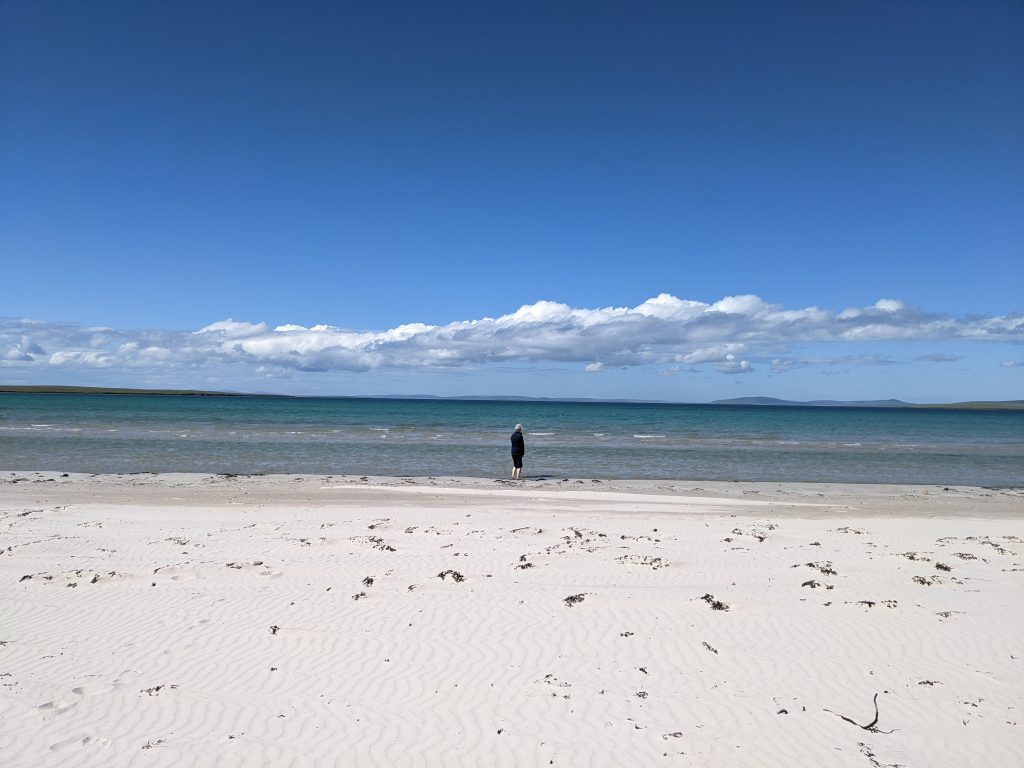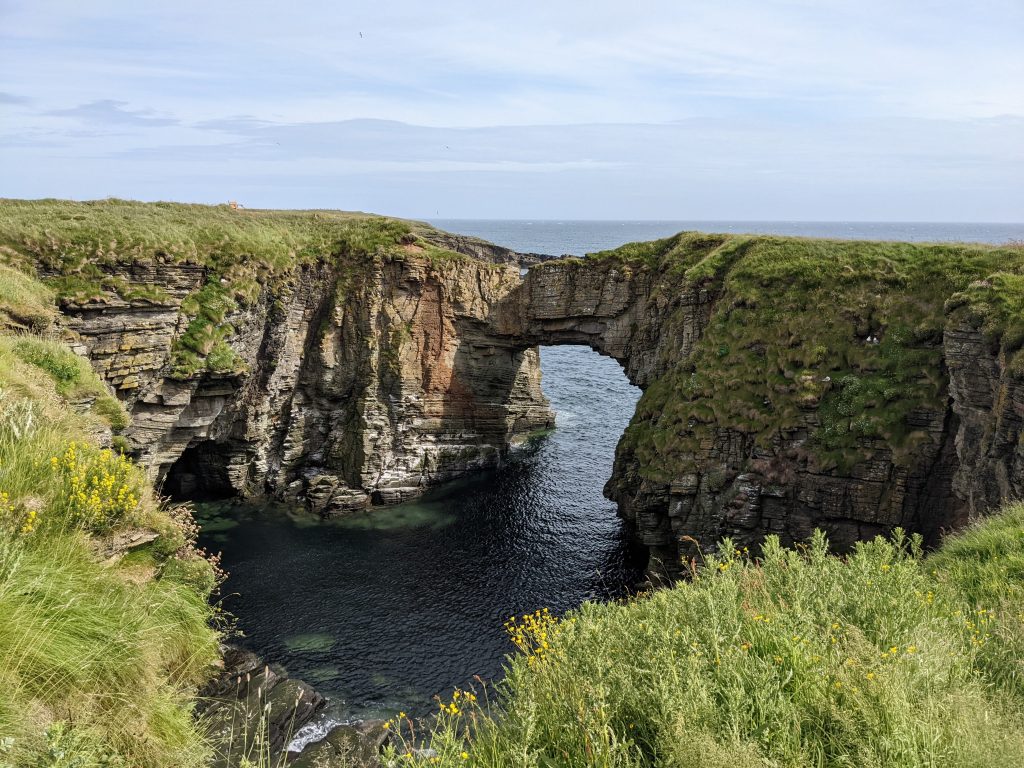
Mingro. I’d be lying if I said we fell in love with Mingro straight away. Obviously, it was a great cottage in a fabulous place, but the truth is we were dog tired, I don’t think anyone had been in the week before, and it smelt a bit “holiday cottagey” as I remembered from the 1990s- about 5% damp. For some reason as well, we just kept getting lost in it and it was tiny! There were two wings – one with the kitchen and hall/bathroom, and then the other at right angles like a T, which had the living room to the right, the bedroom to the left, and an abandoned second bedroom, now a store, straight ahead. We’d had a big lunch so only made a snack of cheese on toast, and whoever had been there last hadn’t made a great job of cleaning some of the utensils and pans. I’m fussy about that kind of thing, so some of them got scrubbed before we used them, and everything else afterwards got a good scouring. It felt strange at first to settle into our TV-less, internet-less living room – though Colin had some wireless speakers which we made a lot of use of in the week. We read our books and combed through the information binder to see how everything worked. That’s when we discovered that the pub in Whitehall was shut. We were also starting to feel a bit cold and that’s when we noticed that two of the heaters – kitchen and living room – hadn’t been switched on. Colin used his immense good sense to realize they need switching on at the wall, but too late to catch the preset timers. It hardly mattered anyway – we were exhausted, and retreated to the bedroom, where the heater had come on, and it was toasty and warm. We pulled the curtains against what was basically still full daylight – Colin put on his eye mask – and settled down for an early night at the end of a very, very long day. I don’t think I stayed awake very long. What a journey. But what a wonderful place to be.
Sunday 26 June 2022

Our first full day was bright and sunny, though with a stiff wind. I guess this is the day I started to really feel what a special place Mingro and Rothiesholm was (we found out later it’s pronounced “Roussam”) with the great big crescent of white sandy beach stretching from the corner of the garden round the Bay of Holland and it was when we realised, we could see seals from the kitchen window, when a few came to visit. I’ll admit though I was still tired from the travelling, and we had a few tricky moments. We decided to do a walk from the door which was only 3.5 miles, and we expected it to be easy – but it turned out to be anything but. For starters we romped off in the wrong direction along the beach. Then when we realized, we thought we’d just reverse the instructions – but in a wild place that you don’t know that turned out to be harder than we thought. From the far end of the beach (which was beautiful), we headed through the dunes to the lane, then manged to lose our way cutting across to the North shore. We ended up trudging along the beach, but it didn’t feel right to me. We tracked all the way back to where we got confused, finally picked up the right path to the North shore and found ourselves with the exact same problem – either walk along the rocky beach or follow the very uneven path along the top of the dunes. We chose mostly the dunes, but it was so tussocky it was like walking in slow motion and took what felt like hours. There were lots of places where feet disappeared from under me, and we were both lucky to get away without broken ankles. I was so relived to finally reach another beautiful sandy beach where we could sit and eat lunch and catch our breath. I started to cheer up then. And after that, just a bit further along the almost impassable dune or cliff top to get to the Bight of Baywest, another gorgeous beach. From here we turned inland, passing over the Hillock of Baywest, which is an unexcavated burial mound. From here we could see exactly where we need to go – just a short way back towards the farm and loch on the other side of the lane from Mingro. But nothing is ever easy! This was also very overgrown – lots of yellow marsh irises – and at times very rough, with nothing like a visible path. Finally, we got back to a gate to the lane, right at the cottage, turned around and saw a sign which said the path was closed as it was unsafe. We couldn’t believe it – there was nothing at the other end – but anyway it was too late. We were back! So that was without doubt the toughest 3.5 miles I have ever walked. Beautiful. But very tiring, and I was intensely relieved to get back to the cottage. I can’t honestly remember what we did the rest of the day. Colin probably had a rest, and I know we treated ourselves to pizza and salad for tea, because neither of us could be bothered to cook, and we probably had a beer. I think I poked about on the beach a bit on my own, watching oyster catchers flying over – the first of many, all of them cross with us, and probably defending nests in the dunes. I read my trash Lin Anderson novel set on Stronsay, and we were warmer with the heaters on – specially when we realized that shutting the living room door would really help. It all started to seem more homely, and more fun. I’d managed to break a mug at the start of the day and had started to feel a bit cursed – but by the time I went to bed I felt blessed. I think we had an early night every night – Colin rarely makes it past ten – and I slept soundly every night. I don’t think I stirred once. The holiday had really begun then.
Monday 27th June 2022

This was without question the most perfect summery day we had on Stronsay, and probably the most relaxing. The sky was electric blue all day with just a few lines of white fluffy clouds and the wind even dropped at times. I think I might have got down to a T shirt at one point or even rolled up my walking trousers. Tropical! Today’s walk was 3.7 miles, slightly longer than Sunday’s but so much easier, it felt like half. We started off by driving down to Whitehall and parking up on the harbour front. This was initially a bit disappointing. The pub was shut (it was taken into community ownership and reopened just after we left), it looked like the bank and registry office were as well, and a lot of the houses were empty and derelict. I think Covid must have hot them hard. If I could afford it I ‘d buy one of these houses – leftovers from the herring industry and do it up to let out, like a shot. Even more disappointing the café we had been banking on to stay open, the Fishmart, was closed as well – and I’d meant to take Colin in for a big piece of cake after our walk. It turned out to always be closed on Mondays – but there was also a sign in the window saying that they had no hot water, so I braced myself for our last resort for catering being closed all week.
The walking though was brilliant today. We walked back out of Whitehall the way we’d come in, and stopped off at the Ayre of Myers, a little white sandy beach which sometimes has seal pups – but none to be seen today. Just a picnic bench with a turf windbreak around it – the Stronsay idea of mass tourism. The we walked up to the top road, turned left a little way, then beside a new phone tower, turned right down a track to a “car park” – nothing more than a rough enclosure, with a gate onto the dunes. This then took us down onto the most stunning beach- St Catherine’s Bay. The white sands stretched for miles in both directions, and what I still just can’t quite believe is = there was no one else there. At all. It felt like a luxury paradise – if you don’t mind having no facilities. I just felt on top of the world. We walked a little way along to the left and found a nice spot at the bottom of the dunes and set up our little camp. We had lunch first, though it was probably a bit early, and the I kicked my boots off and went down to the sea to paddle. It was just perfect – not even too cold. If Id had my costume, I’d have been tempted to swim. I looked back up the beach and Colin was doing his French Duolingo classes on his phone because he’d managed to get a signal (it was patchy). I stayed in, paddling up and down, as long as I could, because I couldn’t bear to leave, but eventually went back. Colin took his turn to walk down to the shore to take some photos while I sunbathed, and then it was time to head off, boot up, and set off back again. (I’ll admit I did have to head off to take a pee in the dunes before we set off, so I hope no one saw). This was just a there and back walk, so we had no problems finding our way back to Whitehall. AS the café was shut, we went into Ebeneezer’s Stores – one of just 2 shops on Stronsay – to buy cake and a few basics to keep us going. I also managed to buy some Star Island soaps for presents to take home, and some slightly dusty old postcards, which didn’t do justice to Stronsay at all, but would do for sending home and a copy of the Orcadian newspaper, which was already almost a week old, but had some great puzzles which kept us busy all week – the crossword nearly killed us. Then we headed back to Mingro in the car for tea and cake.
I can’t remember everything we did after that – it was still early, so Colin probably had a rest. I know we made use of the washing machine because Colin specially had packed very light and was running out of underwear and T shirts! The wind was too wild to pin much out but they dried on the rack in the kitchen window. I know that we also went for a pre-dinner walk along our own beach, Rothiesholm, and met two very friendly farm dogs that came racing over the dunes to meet us when they heard our voices. One followed us all the way back to Mingro and fell asleep outside the kitchen. I think Colin made me his usual speciality – mushroom omelette – and we opened a bottle of wine, I’m not sure if we started on the games that night – I think Mousetrap came first, followed by Dominoes and an ancient version of Trivial Pursuit later. What I know is we had the most beautiful evening and sunset. We quite often walked in the evening the few yards down to the loch to look at all the wading birds like Sanderlings and Shelducks. The sunset over the loch this night was stunning. It was the perfect end to a really lovely day, and I went to bed with my head full of blue skies and fluffy white clouds and clear seas and grassy hot dunes and friendly dogs and both of us completely relaxed and happy. So happy.
Tuesday 28th June 2022

The weather broke a bit today – or it was more mixed, anyway, with some cloud and lots of breezy wind, but with sun later and then there was a slight shower. It was also the most challenging day of walking we did – very rewarding, but a bit scary in places, and by the end completely exhausting. We had got into the rhythm of the holiday by then though – it was either Monday or Tuesday that we discovered “Around Orkney” (or “Around Arkney”) which came on to BBC radio Scotland for 30 minutes at 7.30 AM each morning. I came to love this show – the reports of beef prizes, and high-tech startups, and standing for Orkney council, and problems with Brexit and air navigation, and drawing the semi-finals of the inter-island cup out of a Heroes tin. We listened every morning, drinking tea in bed, before I went off for my shower, and it really became part of the holiday.
The walk today was of slightly indeterminate length- one guide said 6.5 miles, another 7.5 and I can only say that my legs said the latter, and then some. We started at a parking bay near to Odin Bay (there was an information board, but it was empty – more Stronsay mass tourism) and walked a fairly short distance to an amazing rock arch called the Vat of Kirbuster – this is a “gloup” apparently, or a collapsed cave, and is pretty dramatic. From there the cliff walk South got a lot more challenging, but the views were spectacular. We went down to Burgh Head, where the wind was bracing, and the shifted direction down to Lamb Head, past a whole series of rocky inlets and rock towers where hermits had lived but now were just fulmars. Which we were eyeball to eyeball with. I’ll be honest, these cliff paths were pretty wild, and I’m terrible at heights, and in a few places was a bit nervous, but I didn’t really need to be. We saw beautiful wildflowers – orchids and thistle – and got buzzed by oyster catchers and terns who were worried about their nests. We stopped for lunch at Lambs Head, which was gorgeous, even if it was bit grey. There are “brochs” here – basically prehistoric human homes burrowed into the clifftops to get out of the wind, which I guess was as fierce for the Picts as it was for us. Best of all we got our first mass sighting of grey seals, apart from the odd ones who’d popped up to say hello at Rothiesholm. They seemed to love the bay of Houseby and ended up following us along the coast. I thought at this point that we’d cracked this walk, but I turned out to be wrong. We continued on round the bay and took another short break on the shingly beach to with the seals and for Colin to do his French Duolingo (more 4G access), then we headed inland on a dead straight path. I’d thought from here that we “just” had to return to the car by road – but we still had 3 miles to go, and it turned out to be the longest 3 miles I’ve ever walked. It was much of it up hill, and the sun came out as well, so fleeces came off and the scarf I’d started wearing round my hair against the wind. It really turned into a bit of a trudge at this point – and the last bit was about a mile uphill in the teeth of a stiff wind – we could see the car, but it never seemed to get any closer. I’ve not often been so relieved to reach the car again – even though the walk itself was completely memorable. We drove back to Mingro where we basically collapsed onto the big cosy bed for a rest. I think it was a little showery at this point as well. I know I managed to get up later and cook a veggie chilli and rice, and that’s about all I remember of the evening. We probably listened to music, and I think I finished my slightly underwhelming Lin Anderson thriller (which I left behind in the cottage) and moved onto Greenvoe by George Mackay Brown, the Orkney poet, which is one of the best books I’ve ever read, like Dylan Thomas crossed with Orwell. One thing I’m sure of though, is that I had trouble sleeping at all, not even with the almost midnight sun. But walking your feet off will do that to you.



















